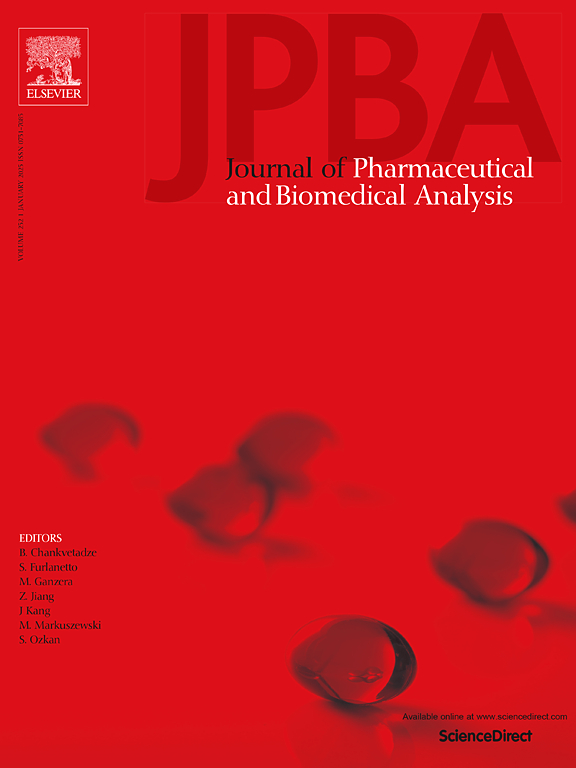A 3D-printed integrated maneuverable device for sensitive colorimetry of Pseudomonas aeruginosa
IF 3.1
3区 医学
Q2 CHEMISTRY, ANALYTICAL
Journal of pharmaceutical and biomedical analysis
Pub Date : 2025-04-27
DOI:10.1016/j.jpba.2025.116934
引用次数: 0
Abstract
Timely and sensitive monitoring of pathogens in clinical specimen is highly demanded for efficient control and precise treatment of infectious diseases. Herein, a 3D-printed maneuverable device integrating incubation, washing, and detection functions was manufactured for colorimetry of Pseudomonas aeruginosa (P. aeruginosa) using transparent resin. The device combined with magnetic beads (MBs) can achieve specific separation and efficient enrichment of P. aeruginosa. Furthermore, it can be directly fixed onto a 96-well plate holder for colorimetry. Specifically, a P. aeruginosa bacteriophage termed as JZ1 acquired from river water was applied as a recognition reagent to functionalize the separation vectors MBs. Then, a nanoconfinement MOFs material termed as PCN-222(Pt) with remarkable peroxidase-like activity was conjugated with polymyxin B to act as a signal tracer. With the formation of target bacterial complexes, the bound PCN-222(Pt) catalyzed the color reaction of 3,3′,5,5′-tetramethylbenzidine to enable quantitative colorimetry of P. aeruginosa by the maneuverable device. With this device, P. aeruginosa can be quantified within 40 min, with a dynamic range of 1.9 × 102 ∼ 1.9 × 106 cfu mL−1. The results for colorimetry of P. aeruginosa in diverse sample matrixes demonstrated its satisfactory practicability. This work provides a facile, timely, and cost-effective technique for point-of-care testing of pathogens.
一种用于铜绿假单胞菌灵敏比色的3d打印集成可操作装置
及时、灵敏地监测临床标本中的病原体,是有效控制和精确治疗传染病的重要手段。本研究利用透明树脂制备了一种集孵育、洗涤和检测功能于一体的3d打印可操作装置,用于铜绿假单胞菌(P. aeruginosa)的比色测定。该装置与磁珠(mb)结合可实现铜绿假单胞菌的特异分离和高效富集。此外,它可以直接固定在96孔板支架上进行比色测定。具体来说,从河水中获得的铜绿假单胞菌噬菌体JZ1被用作识别试剂来功能化分离载体MBs。然后,将具有过氧化物酶样活性的纳米约束mof材料PCN-222(Pt)与多粘菌素B偶联,作为信号示踪剂。随着目标细菌复合物的形成,结合的PCN-222(Pt)催化3,3 ',5,5 ' -四甲基联苯胺显色反应,实现了可操作装置对铜绿假单胞菌的定量比色。使用该装置,铜绿假单胞菌可在40 min内定量,动态范围为1.9 × 102 ~ 1.9 × 106 cfu mL−1。不同样品基质中铜绿假单胞菌的比色分析结果表明了该方法的实用性。这项工作为即时检测病原体提供了一种简便、及时和具有成本效益的技术。
本文章由计算机程序翻译,如有差异,请以英文原文为准。
求助全文
约1分钟内获得全文
求助全文
来源期刊
CiteScore
6.70
自引率
5.90%
发文量
588
审稿时长
37 days
期刊介绍:
This journal is an international medium directed towards the needs of academic, clinical, government and industrial analysis by publishing original research reports and critical reviews on pharmaceutical and biomedical analysis. It covers the interdisciplinary aspects of analysis in the pharmaceutical, biomedical and clinical sciences, including developments in analytical methodology, instrumentation, computation and interpretation. Submissions on novel applications focusing on drug purity and stability studies, pharmacokinetics, therapeutic monitoring, metabolic profiling; drug-related aspects of analytical biochemistry and forensic toxicology; quality assurance in the pharmaceutical industry are also welcome.
Studies from areas of well established and poorly selective methods, such as UV-VIS spectrophotometry (including derivative and multi-wavelength measurements), basic electroanalytical (potentiometric, polarographic and voltammetric) methods, fluorimetry, flow-injection analysis, etc. are accepted for publication in exceptional cases only, if a unique and substantial advantage over presently known systems is demonstrated. The same applies to the assay of simple drug formulations by any kind of methods and the determination of drugs in biological samples based merely on spiked samples. Drug purity/stability studies should contain information on the structure elucidation of the impurities/degradants.

 求助内容:
求助内容: 应助结果提醒方式:
应助结果提醒方式:


